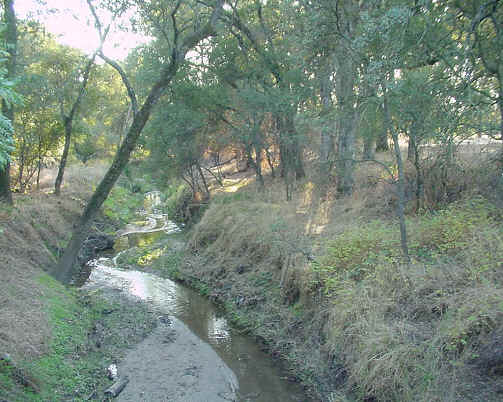Riparian refers to the transition area between a body of water (pond, lake, creek, or river) and the uplands. This area is commonly referred to as the bank. Often the plants and animals associated with the riparian area are heavily influenced by the body of water because of water availability or disturbance due to flooding. Here in Sacramento, riparian areas often consist of trees such as oaks, willows and cottonwoods and shrubs such as wild rose, elderberry, poison oak, and blackberries. Riparian habitat can range from an open grassy bank to a closed canopy of large mature trees.

Arcade Creek in Citrus Heights photo by PER staff
When compared to grasslands and upland forest, riparian areas have the highest species diversity and productivity for both flora and fauna. Over 135 species of California birds such as the willow flycatcher, yellow-billed cuckoo and red-shouldered hawk either completely depend upon riparian habitats or use them preferentially at some stage of their life. Riparian habitat provides food, nesting habitat, cover, and migration corridors. Another 90 species of mammals, reptiles, invertebrates and amphibians such as California red-legged frog, valley elderberry longhorn beetle, riparian brush rabbit, steelhead, Chinook salmon, western pond turtle, Sacramento splittail, giant garter snake, and Swainson's hawk depend on California's riparian habitats.
Riparian habitat provides riverbank protection, erosion control and improved water quality. In addition, riparian areas provide numerous recreational and aesthetic values. Locally the American River corridor provides biking, horseback riding, bird watching, fishing, and boating.
Historic records indicate that the Central Valley supported wide swaths of riparian oak woodland following stream and river channels. A mix of interior live oaks, blue oaks, and valley oaks, as well as other native tree and shrub species, spread outward from the riverbanks for miles. Riparian forests have largely been lost to stream channelization, development, logging, grazing and water diversion throughout the west. Only 5% to 10% of California's original (pre-European contact) riparian habitat exists today and much of the remaining habitat is in a degraded condition. In the Sacramento River Valley, only 25,000 of the estimated 500,000 acres of riparian habitat that existed in 1850 remain today.
Sacramento County is fortunate to have a few locations of prime riparian forests protected in preserves and recreation areas. Some of these locations include the American River Parkway, the Dry Creek Parkway, the Cosumnes River Preserve, and the Beach/Stone Lakes National Wildlife Refuge. Additional preservation and restoration is being performed on the Sacramento Regional County Sanitation Districts Buffer Lands area.
Sacramento County has adopted numerous policies in favor of protecting riparian areas. These policies can be found in the 1993 Sacramento County General Plan Conservation Element. County policy CO-62 ensures no net loss of marsh and riparian woodland acreage, values or functions. County policy CO-67 states that parcels shall not be created wherein much of the parcel area would comprise marsh or riparian habitat rendering the parcel unbuildable except when within a floodplain corridor or to be dedicated to and maintained by the County for flood control, drainage, and wetland maintenance.
The state and federal government require agreements and permits when work activity occurs in or over creeks and rivers. The California Department of Fish and Wildlife requires a Section 1600 Lake and Streambed Alteration Agreement (also known as LSA Agreement) to be obtained when working in or around any stream, river or lake. In accordance with Section 404 of the Clean Water Act the U.S. Army Corps of Engineers requires a permit for any filling, dredging, excavation or other modification to waters of the U.S. Both the state and federal government may require biological survey prior to construction, the implementation of measures to avoid impact, and habitat restoration following construction.
Related Links
Government:
Non-Profits Working to Protect Riparian Habitat
